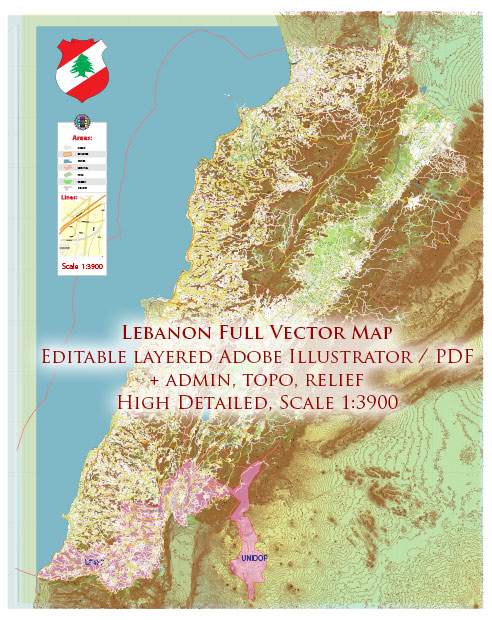Lebanon is a small but culturally rich country located on the eastern shore of the Mediterranean Sea in the Middle East. Vectormap.Net provide you with the most accurate and up-to-date vector maps in Adobe Illustrator, PDF and other formats, designed for editing and printing. Please read the vector map descriptions carefully. Here’s a detailed description covering various aspects of Lebanon:
- Geography:
- Location: Lebanon is situated in Western Asia, bordered by Syria to the north and east, and Israel to the south. To the west, it has a coastline along the Mediterranean Sea.
- Topography: The country is characterized by a narrow coastal plain, the Lebanon Mountains (part of the larger Mount Lebanon range), and the Bekaa Valley, which lies between the coastal range and the Anti-Lebanon Mountains on the eastern border.
- Capital and Major Cities:
- Capital: Beirut is the capital and largest city of Lebanon. It is a vibrant and cosmopolitan city known for its historical significance, cultural diversity, and economic importance.
- Other Cities: Tripoli, Sidon (Saida), and Tyre (Sour) are other significant cities in Lebanon.
- Population and Culture:
- Population: Lebanon have a population of around 6 million people.
- Cultural Diversity: Lebanon is known for its cultural diversity, with a mix of Arab, Mediterranean, and Western influences. It has a rich history, evident in its archaeological sites, historical landmarks, and cultural traditions.
- Language:
- Official Languages: Arabic is the official language, but French and English are widely used in business and education.
- Religion:
- Religious Diversity: Lebanon is known for its religious diversity. The two main branches of Islam (Sunni and Shia) coexist with various Christian denominations (Maronite, Greek Orthodox, etc.). There are also small Druze and other religious communities.
- Government:
- Political System: Lebanon has a parliamentary democratic system.
- Confessionalism: Lebanon operates on a confessional political system, which means that political power is distributed among the country’s religious communities.
- Economy:
- Economic Sectors: Lebanon’s economy has traditionally been diverse, with sectors such as banking, tourism, and services playing a significant role.
- Challenges: The country has faced economic challenges, including high public debt and political instability.
- History:
- Ancient Civilization: Lebanon has a rich history dating back to ancient times, with cities like Byblos and Tyre being important centers of civilization.
- Modern History: Lebanon gained independence from French mandate in 1943 and has experienced periods of conflict, including the Lebanese Civil War (1975-1990).
- Cuisine:
- Diverse Cuisine: Lebanese cuisine is renowned for its diverse and flavorful dishes. Common ingredients include olive oil, garlic, herbs, and fresh fruits and vegetables. Popular dishes include hummus, tabbouleh, falafel, and kebabs.
- Landmarks and Tourism:
- Historical Sites: Lebanon is home to several UNESCO World Heritage Sites, including the ruins of Baalbek, Anjar, and the historic city of Byblos.
- Natural Beauty: The country offers scenic landscapes, from the Mediterranean coastline to the mountainous regions.
- Current Challenges:
- Political Instability: Lebanon has faced ongoing political challenges and occasional tensions with neighboring countries.
- Economic Crisis: The country has been grappling with economic difficulties, including high inflation and unemployment.


 Author: Kirill Shrayber, Ph.D.
Author: Kirill Shrayber, Ph.D.